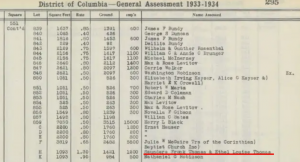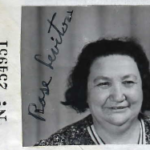Let’s call this an SOP, standard operating procedure, for what I’m doing. And what am I doing? I’m doing some neighborhood history, but more along the lines of neighborhood historical fact gathering. History is about a story to be told. The problem is that I get another piece of information and it kinda throws a monkey wrench into the narrative. Here I gather the info, then try to tell a tale.
For this series- Property Owners of Truxton Circle, which could later apply to Black Home Owners of Truxton Circle, there are a couple of resources I use to find out about the owners.
First is the list of property owners for a particular time period of time. I got mine from the General Land Assessment Files, 1902-1938 at the National Archives. There are a few parts of the assessments digitized and in the catalog. There’s 1902-1903 Volume 1 (in two parts) for Squares 1-555 and Volume 2 Squares 556-1301. For 1933-1934, it seems they only go up to Square 727. For my current series, I picked a small part of Square 551 from the 1933-1934 assessment. Second, but this could have been first, are the real estate or fire maps from the Library of Congress. If you know what city square you’re looking for this is second. I’m using the 1919 Baist Real Estate Atlas. It’s pretty much Old City. There are earlier Baist maps, but they don’t cover Truxton Circle. The Library of Congress also has Sanborn fire maps, but you have to be on-site to use those. This helps place the square and lot number with maybe an address. The maps are not always correct with the addresses, but at least you know where the lot is on the block.
Second, but this could have been first, are the real estate or fire maps from the Library of Congress. If you know what city square you’re looking for this is second. I’m using the 1919 Baist Real Estate Atlas. It’s pretty much Old City. There are earlier Baist maps, but they don’t cover Truxton Circle. The Library of Congress also has Sanborn fire maps, but you have to be on-site to use those. This helps place the square and lot number with maybe an address. The maps are not always correct with the addresses, but at least you know where the lot is on the block.
Then you go to the Recorder of Deeds, and use their Online Public Records (August 1921-Present). You get the name and the SSL (square and lot) from the assessment, then you take that name and or the SSL and plug that in. Squares and lots are 4 digits. For example Square 2 and lot 3 would be 0002 and 0003. If the lot is a letter then 000A. Squares with letter suffixes are tricky. Put that in the front but also search without the letter suffix, because typos happen. Deeds are land changing hands. Trusts are loans or borrowed money. This is a trove of info, with notations of death, if the person is married and to whom, and a bunch of good stuff.

Last is the Ancestry Library database. This is just like the Ancestry.com site you pay for, except you can’t make changes, have a family tree or do anything cool. It is available through the DC Public Library and your library card. Here, I can see if the owners’ family may have lived in Truxton Circle or the address owned, by using the Census or draft cards. In the case of the Levitovs, I was able to get photos from their immigration papers. Sometimes people have really common names and the info from the Recorder of Deeds helps narrow down who is the actual person you’re looking for. Ancestry has wills, family trees, marriage records, the Social Security Death Index, obituaries, and city directories.
Assembling it all together to make history
If you are doing the history of your neighborhood or just a block you could apply the same tools and techniques to your project. Maybe you’re in other parts of the city where the history has been explored six ways to Sunday. Well. You have some extra tools. If you’re in Georgetown you could mine the Old Georgetown Files. Also those previous histories tend to be more broad, bird-eye views. This way is more earthbound.
Once I’ve got the land information and the genealogical information about the owner, I then make some sort of history write up. What I gathered or dug up dictates the story.
Sometimes the story is with the lot. Or lots. Larger lots and their numbers get broken up and the confusion that entails creates a story.
Sometimes the story is the owner and their family. Did they live on the property? When and for how long? Who did they rent to (cross reference with TruxtonCircle.org spreadsheets) if they did rent the property. What is their story? Sometimes the story can be about Truxton Circle, and sometimes it’s just a short genealogy.
The Story So Far
There was a story I was trying to tell with Black Home Owners of Truxton Circle, that African Americans, even in this “Southern” town owned land. With the more general Property Owners series, I am looking at the possible landlords. Sometimes they are landlords. Sometimes they are owner occupants. And sometimes, they are both. Many times, they are just dead and it is the remaining family members tying up loose ends, closing up estates, doing stuff. I also discover female land owners. Sometimes they inherit the land, and sometimes a gal just buys a little something for herself and her investment portfolio (both Black and White).
Unless I get a grant ($$$), I probably won’t be able to do this for the whole neighborhood. It is a bit tedious and I’m not sure if I have an audience for this history.
